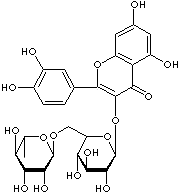PRODUCT IDENTIFICATION
250249-75-3 (Trihydrate)

H.S. CODE
TOXICITY
CLASSIFICATION
PHYSICAL AND CHEMICAL PROPERTIES
AUTOIGNITION
NFPA RATINGS
REFRACTIVE INDEX
Stable under ordinary conditions. Hygroscopic, light sensitive.
GENERAL DESCRIPTION & APPLICATIONS
Members of rutin molecules
|
Product |
CAS RN |
| Rutinose | 90-74-4 |
| Rutin | 153-18-4 |
| Hesperidin | 520-26-3 |
| Narcissin | 604-80-8 |
| Tetra(hydroxyethyl)rutoside | 6980-20-7 |
| Troxerutin | 7085-55-4 |
| Ascorutin | 8067-12-7 |
| Rutin sodium sulfate | 12768-44-4 |
| Eriocitrin | 13463-28-0 |
| Narirutin | 14259-46-2 |
| Tamarixetin 7-rutinoside | 14265-53-3 |
| Delphinidin-3-rutinoside | 15674-58-5 |
| Kaempferol 7-neohesperidoside | 17353-03-6 |
| Keracyanin | 18719-76-1 |
| Monoxerutin | 23869-24-1 |
| Veronicastroside | 25694-72-8 |
| Ethoxazorutoside | 30851-76-4 |
| Isorhamnetin-3-O-rutinoside-7-O-glucoside | 55481-91-9 |
| Rutin S | 64755-26-6 |
| Diethanolamine-rutin | 69344-84-9 |
| Rutin-N-mustard | 85625-48-5 |
| Nirurin | 96253-68-8 |
| Rutin sulfate | 108916-86-5 |
| Isorhamnetin-3-O-rutinoside-4'-O-glucoside | 111393-97-6 |
| Violdelphin | 126417-59-2 |
| Swertiamacroside | 128585-97-7 |
| D-Glucose-rutin | 130603-71-3 |
| Rutin butyryl ester | 131981-32-3 |
| 2',5,5',7-Tetrahydroxy-flavanone-7-O-rutinoside | 153286-43-2 |
| Rutin hydrate | 207671-50-9 |
|
Rutin trihydrate |
250249-75-3 |
APPEARANCE
ASSAY
Pass
0.004% max
0.004% max
0.004% max
5.5 - 9.5%
5.0% max
IRON
10ppm max
HEAVY METALS
10ppm max
GENERAL DESCRIPTION OF FLAVONOID
- Flavonols (Hydroxy derivatives of flavone): Fisetin, Galangin, Kaempferide, Kaempferol, Morin, Myricetin, Myricitrin, Quercetin, Quercetrin, Rhamnetin, Robinin, Rutin, Spirenoside
- Flavones (skeleton: 2-phenylchromen-4-one): Apigenin, Baicalein, Chrysin, Diosmetin, Diosmin, Flavone, Luteolin, Rpoifolin,Tangeretin, Techtochrysin, Rhamnazin, Nobiletin, Natsudaidain.
- Isoflavones (skeleton: 3-phenylchromen-4-one): Daidzin, Genistein, Irilone, Luteone, Prunetin, Pratensein,
- Flavonones (derivation by reduction of the 2(3) C=C bond): Eriodictyol, Hesperidin, Hesperetin, Likvirtin, Naringin Naringenin Pinocembrin
- Flavanols (derivation by reduction of the keto group):(+)-Catechin, (+)-Gallocatechin, (-)-Epicatechin (EC), (-)-Epigallocatechin (EGC), (-)-Epicatechin 3-gallate (ECG), (-)-Epigallocatechin 3-gallate (EGCG), Theaflavin, Theaflavin 3-gallate, Theaflavin 3'-gallate, Theaflavin 3,3' digallate, Thearubigins
- Anthocyanidins (aglycones of the glycoside anthocyanins): Apigeninidin, Cyanidin, Delphinidin, Diosmetinidin, Guibourtinidin, Fisetinidin, Luteolinidin, Malvidin, Pelargonidin, Peonidin, Robinetinidin, Tricetinidin, Capensinidin, Petunidin, Europinidin, Aurentinidin, Columnidin, 5-Desoxy-malvidin, 5-Desoxy-peonidin, Hirsutinidin, Rosinidin
PRICE INFORMATION